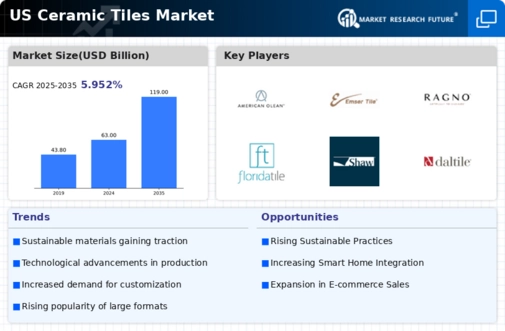Growth in Construction Activities
The ceramic tiles market is significantly influenced by the robust growth in construction activities across the United States. With an increase in both residential and commercial construction projects, the demand for ceramic tiles is expected to rise correspondingly. Recent data suggests that the construction sector has expanded by approximately 8% in the last year, leading to a heightened need for durable and aesthetically pleasing flooring solutions. Ceramic tiles are favored for their resilience and ease of maintenance, making them a popular choice among builders and architects. This trend is further supported by government initiatives aimed at boosting infrastructure development, which is likely to sustain the momentum in the ceramic tiles market. As construction activities continue to flourish, the market is poised for substantial growth, driven by the increasing adoption of ceramic tiles in new builds and renovations.
Expansion of Distribution Channels
The ceramic tiles market is experiencing a notable expansion of distribution channels, which is enhancing accessibility for consumers and driving sales growth. Retailers are increasingly diversifying their offerings by incorporating online platforms alongside traditional brick-and-mortar stores. This shift is particularly relevant in the context of the growing trend towards e-commerce, where consumers are seeking convenience and a wider selection of products. Recent data suggests that online sales in the ceramic tiles market have increased by approximately 20% over the past year, indicating a shift in purchasing behavior. As manufacturers and retailers adapt to this trend, the ceramic tiles market is likely to benefit from improved distribution strategies that cater to the evolving preferences of consumers. This expansion not only facilitates greater market penetration but also enhances competition among suppliers, ultimately benefiting the end consumer.
Rising Demand for Aesthetic Appeal
The ceramic tiles market experiences a notable surge in demand driven by the increasing consumer preference for aesthetic appeal in residential and commercial spaces. Homeowners and designers are gravitating towards ceramic tiles due to their versatility in design, color, and texture. This trend is reflected in the market data, which indicates that the aesthetic segment accounts for approximately 35% of total sales in the ceramic tiles market. As consumers seek to enhance the visual appeal of their interiors, manufacturers are responding with innovative designs and finishes, further propelling market growth. The emphasis on aesthetics is particularly pronounced in urban areas, where space optimization and style are paramount. Consequently, the ceramic tiles market is likely to continue evolving, with a focus on providing visually striking options that cater to diverse consumer tastes.
Increased Focus on Eco-Friendly Products
The ceramic tiles market is witnessing a growing emphasis on eco-friendly products, driven by consumer awareness and demand for sustainable building materials. As environmental concerns become more pronounced, manufacturers are increasingly adopting sustainable practices in the production of ceramic tiles. This includes the use of recycled materials and energy-efficient manufacturing processes. Recent surveys indicate that approximately 40% of consumers are willing to pay a premium for eco-friendly tiles, suggesting a significant market opportunity for manufacturers who prioritize sustainability. The shift towards eco-friendly products is not only beneficial for the environment but also aligns with the broader trends in the construction industry, where green building certifications are becoming more prevalent. Consequently, the ceramic tiles market is likely to expand as it adapts to these changing consumer preferences and regulatory requirements.
Technological Innovations in Manufacturing
Technological advancements in manufacturing processes are playing a pivotal role in shaping the ceramic tiles market. Innovations such as digital printing and advanced glazing techniques have revolutionized the production of ceramic tiles, allowing for greater customization and improved quality. These technologies enable manufacturers to produce tiles that mimic natural materials, such as wood and stone, at a fraction of the cost. Market data indicates that the adoption of these technologies has led to a 15% increase in production efficiency, thereby reducing costs and enhancing profitability for manufacturers. As the industry continues to embrace these innovations, the ceramic tiles market is likely to witness an influx of new products that cater to evolving consumer preferences. This technological evolution not only enhances product offerings but also positions the ceramic tiles market as a competitive player in the broader flooring industry.























Leave a Comment